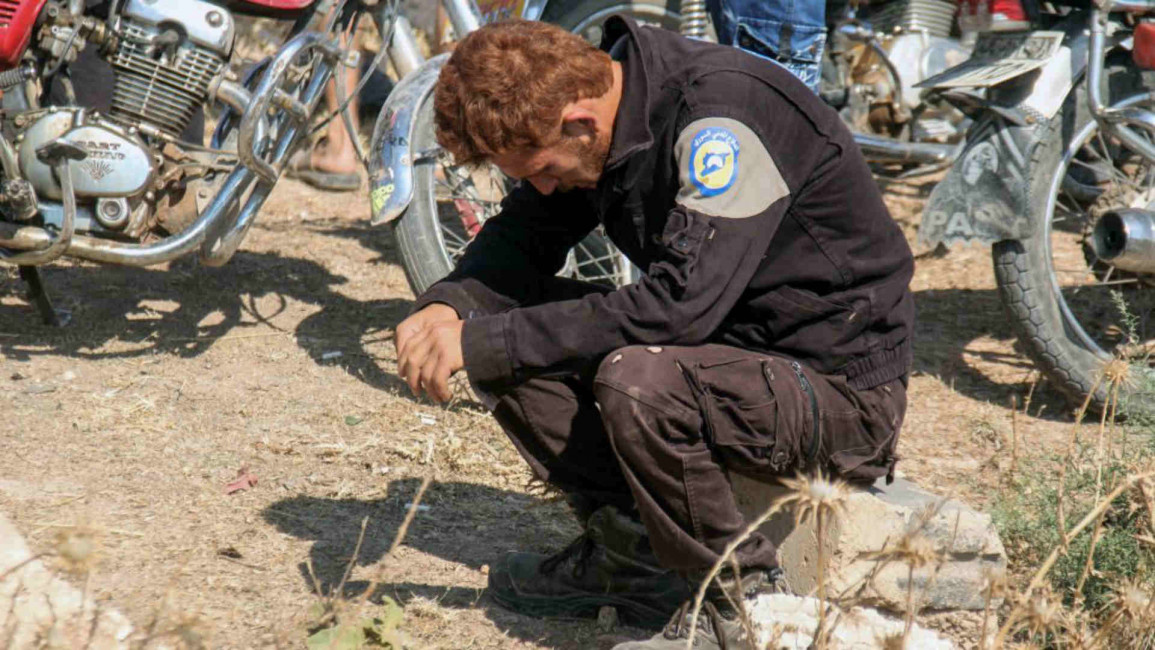
Unreported and left behind: The fate of Syria's remaining White Helmets
Once several rescuers and their families had made it to safety, there was a fierce debate. On one hand, many reporters celebrated the evacuation and considered it a victory for the Syrian rescue team, but on the other, some considered the evacuation clear evidence that the White Helmets are simply part of the 'Zionist conspiracy' against the Syrian state and its president, Bashar al-Assad.
As the news cycle moved on, and the evacuation of the Syrian first responders fell out of the spotlight, I came across a letter written by Raed al-Saleh, head of the White Helmets, sent to its own Civil Defense members.
As I read through the two-page document, I realised that only 98 members out of the 700 operating in the area, Daraa, were successfully rescued. Raed added, "it is highly unlikely that another rescue will take place."
The rest of the team was encouraged to choose what they thought was the best option in terms of their safety. The final part of the letter read, "whatever your decision is, your great noble work will always be appreciated."
 |
At best, the lives of ordinary Syrians remain of secondary importance |  |
Today, almost 600 of them remain in Syria, forced to decide their fate. Some - 82 to be exact - made it safely to Idlib.
Ahmad, for example, who I was able to reach through WhatsApp, has been a volunteer with the group since May 2015. The 34-year-old volunteer was on the first green bus evacuated from Daraa to Idlib. When Ahmad signed up to be evacuated, he did so under a fake name and did not mention that he was a member of the White Helmets.
"Today we are targeted by everyone," Ahmad told me. "First, I did not know what to expect from the Syrian government forces checkpoints on the way to Idlib, and, as a Civil Defense member, I did not feel safe either. I am also aware of what HTS - Tahrir al-Sham - did there."
Twitter Post
|
Ahmad's fears are justified. The Syrian government has made it clear that everyone affiliated with the White Helmets is considered a terrorist. A document I recently received from Daraa demonstrates that Syrian intelligence forces have mandated that the first condition towards obtaining so-called "reconciliation" - a euphemism for being spared imprisonment or execution - is to provide information about members of the White Helmets.
Seven of Ahmad's colleagues were murdered last year in Idlib, in a small village called Sarmin, which was, and remains, under the control of HTS. This murder came after a series of death threats aimed at members of the White Helmets.
But, not everyone chose to take the risk and flee to Idlib. In fact, the majority - almost 400 members - stayed in Daraa, which was recently seized by government forces. Some chose to stay, like Abo Kenan who opted to remain in his home.
After he saw what had happened to the displaced people from Ghouta, Homs and other parts of the country who left for Idlib, Abo Kenan told me, "I have four children, the oldest is 13 and the youngest is 3, I don't want them to go through such humiliation."
Others were forced to stay because they had no way to leave. "I want to leave but I can't, there are no roads, people from my area - southwest of Daraa - couldn't reach the evacuation buses in the north," Abo Yacoub al-Hourani told me.
The 28 year-old volunteer has been with the White Helmets for three years. "Since I started, I never expected anyone to guarantee my safety. I did my job and I don't regret it."
 |
'It's like a slow death,' he tells me. 'You know you will be killed but you are just waiting, not knowing when.' |
Abo Yacoub is not sure of what will happen to him. "It is like a slow death," he tells me. "You know you will be killed but you are just waiting, not knowing when. I can't do anything but to hope that something will change," he told me.
Twitter Post
|
While the biggest hope for people like Ahmad, Abo Kenan, and Abo Yacoub is simply staying alive, their struggle for survival and the tough choices they were forced to make are apparently no longer worthy of news headlines or fierce debate.
The media attention given to those members who are not sure if they will be alive by the time this piece is published is by no means close to the degree of attention paid to the rescue operation itself.
Credit where it's due, many reporters did, and still do, a great job of keeping up with the daily news coming from Syria and its eight years of war.
However, for the majority of news outlets, clips and pitches from Syria only matter if they are of geopolitical or international significance. At best, the lives of ordinary Syrians remain of secondary importance. The recent development in the story of the White Helmets is but one example among many others.
Unfortunately, Ahmad, Abo Kenan, Abo Yacoub, and their stories do not make the grade. Waiting, anticipating death, struggling for survival and making tough decisions, is not 'news', though, it is very much part of the lived reality of long-term conflicts like the Syrian one.
Lamentably, as long as the problem is contained inside Syria's borders, with no international angle or geopolitical spin, it will not grab the attention of readers and will continue to go underreported.
Follow her on Twitter: @loubnamrie
Opinions expressed in this article remain those of the author and do not necessarily represent those of The New Arab, its editorial board or staff.


![Minnesota Tim Walz is working to court Muslim voters. [Getty]](/sites/default/files/styles/image_684x385/public/2169747529.jpeg?h=a5f2f23a&itok=b63Wif2V)




